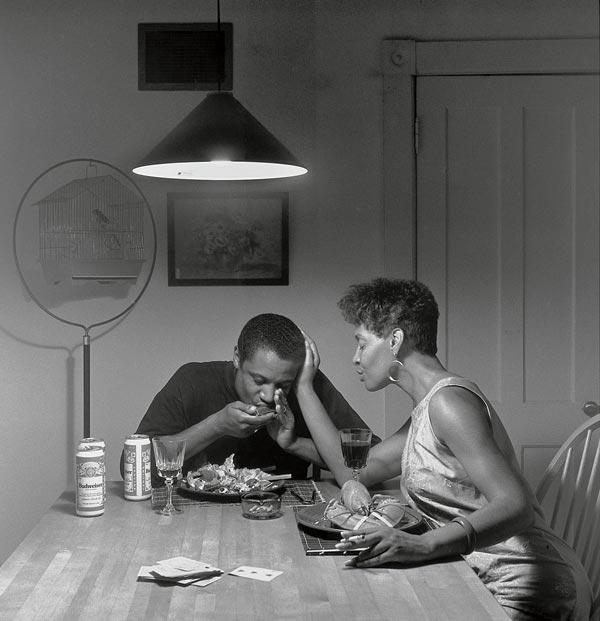Readings
I was fascinated to learn that, after the racist white feminist press Persephone dropped This Bridge, women of color feminists including Barbara Smith and Audre Lorde worked together to found their own radical feminist press by and for women of color, Kitchen Table, in 1980, with which they kept This Bridge in circulation (Adair and Nakamura, 261). This immediately reminded me of Carrie Mae Weems’s historic exhibition, her Kitchen Table photo series, in 1990. Both the feminist press and Weems’s photo series chose to center the kitchen table in projects that defended women of color’s and queer women’s access to intimate justice.

Members of the Kitchen Table Press. Source: Kitchen Table Literary Arts. https://www.kitchen-table.org/
For the radical feminist press, the name Kitchen Table immediately announces the editors’ commitment to prioritizing praxis over theory. There are many crucial contrasts with the racist white feminist title “Persephone” – a reference to an ancient Greek goddess and princess who, in a thinly veiled fruit allegory, disobeys injunctions against sex before marriage. “Persephone” appeals to the racist european cult of claiming ancient Greek and Roman slaveholding and colonizing societies as whitewashed cultural forebears to europe and the united states. The white feminist invocation of “Persephone” defines freedom in a very limited and individualistic sense: a princess’s desire to choose heterosexual partners without consequences.
In contrast, Kitchen Table locates freedom in direct action more than theory or myth, in the lives of ordinary women rather than the elite. Persephone is a fictional character; the Kitchen Table is a very real place. Kitchen Table recalls a linkage of necessity and creativity in the full dimensions of Lorde’s “Uses of the Erotic” that rejects heteronormativity, superficial pornographic consumerism, and freedom without accountability. Rather than representing the name of an individual woman, Kitchen Table names a space that has functioned at once as a home and a workplace for working women throughout history, a space within which women are, through the press, finally invited to define and name themselves.
Similarly, in The Kitchen Table Series (1990), Carrie Mae Weems brilliantly subverts the anthropological gaze of the camera.[1] She acts as both object – that which is captured by the lens – and subject – the framer, editor, and namer of what can be seen. For Weems, the kitchen table does not symbolize political isolation; a lamp illuminates the kitchen table like a stage, or a factory floor. Largely a homosocial space shared by women, in which men feature only as visitors, never as fixtures, the kitchen table represents a political economic arena in its own right. Weems’s kitchen table is entangled with and helps shape the mainstream masculinist, white supremacist political landscape, rather than existing “outside” it.
The fact that the essential work Black women expend in kitchens is perennially unpaid and often required in addition to a full day’s work at a formal job risks refiguring racist and patriarchal exploitation. Weems’s Kitchen Table explores the contradictory potentialities of the kitchen: on the one hand, as a landmark of the ongoing, unredressed labor given by and seized from Black women; and on the other hand, as a radical commons out of which the liberatory possibilities of communities and the sustenance of generations can grow.
In Untitled (Eating lobster), a man at the head of the table hungrily sucks lobster, leaving shells behind. Weems’s food is untouched as she leans over to caress the man. Behind them, a bird sits in a looming cage. Maya Angelou wrote that the bird’s wings are clipped and her legs are tied. But Weems’s limbs are unchained and her kitchen has no bars. What bonds make her stay and pull her towards the man she feeds – force or love, pleasure or obligation, delight or debt? Can either/or questions help us understand her position?

Carrie Mae Weems, Untitled (Eating lobster), 1990 © the artist
The kitchen table as a social economic institution analyzed by Weems and Adair and Nakamura’s reflection on the Kitchen Table as a radical feminist press by and for women of color raise similar dilemmas. After recounting women’s struggles to gain access to books by women of color that were routinely abandoned out of print by racist mainstream publishers, Adair and Nakamura in “Digital Afterlives” give credit to online networks of radical free information sharing, while also pointing out troubling continuities with legal systems of exploitation. Spaces for “digital consciousness raising on Tumblr” serve as a
“feminist classroom[,] but one in which nobody – not the authors of This Bridge, not the unknown laborers who scanned and uploaded hundreds of pages, not the feminists of color writing and critiquing the work online – was compensated for providing [this] education. Nobody, that is, except the media corporation Yahoo, which owns and sells advertising space on Tumblr. […] [Thus,] both the legally distributed book and the pirated version online raise ethical concerns about the uneven distribution of work, ownership, and social power in pedagogical spaces” (Adair and Nakamura, 256).
For example, the Kitchen Table press survived in part by taking advantage of personal relationships with people – predominantly women of color – who were committed to the cause of circulating their radical message, which spared the press the cost of hiring paid staff to do the same work. Adair and Nakamura add hastily, “Of course, we do not equate these acts of solidarity with the exploits of racial capital” (262). Ultimately, however, “even ‘revolutionary’ pedagogical networks inevitably reproduce some racial and gendered dynamics of unremunerated work,” including work that is not counted or credited as work (263). Is the kitchen table a home or a workplace? A product of public labor or private love? An appliance serving at a woman’s convenience, or a domineering institution in whose framework her life plays out, like a cross-section of a dollhouse? If it is both, what does that tell us about freedom and the work of getting free?
1. My sources for analyzing Weems’s Kitchen Table are: (1) O’Grady, Megan, “How Carrie Mae Weems Rewrote the Rules of Image-Making,” The New York Times, 2018. (2) Kelsey, Hall, Tillet, Bey, and Blessing, “Around the Kitchen Table,” Aperture, No. 223, Vision & Justice (Summer 2016), 52-56.




